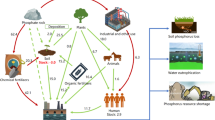Abstract
Linz-Donawitz (LD) slag is a byproduct of the steelmaking industry and contains about 30% Ca, 20% Fe, 5% Mg and 1.4% P. For its application as flux in steelmaking, the phosphorus content has to be minimized. Bio-dephosphorization of the LD slag was attempted using bacterium Frateuria aurentia to remove insoluble phosphorus. In 13 and 30 days of leaching under appropriate conditions, about 72% and 90%, respectively, of the phosphorus could be leached from the LD slag in the presence of the bacteria at 20% pulp density. The amount of carbon source seems to be important for phosphorus solubilization by bacteria. This is a novel method for dephosphorization of LD slag and subsequent waste utilization. The dephosphorized slag can thus have application as a fluxing material in iron and steel production.
Similar content being viewed by others
References
Alexander, M., 1977, Introduction to Soil Microbiology, Wiley, New York.
Banik, S., and Dey, BK., 1982, “Available phosphate content of an alluvial soil is influenced by inoculation of some isolated phosphate-solubilizing microorganisms,” Plant Soil, Vol. 69, pp. 353–64.
Cunningham, J.E., and Kuiack, C., 1992, “Production of citric and oxalic acids and solubilization of calcium phosphate by Penicillium bilaii” Appl. Environ. Microbiol., Vol. 58, pp. 1451–1458.
Goldstein, A.H., 1986, “Bacterial solubilization of mineral phosphate historical perspectives and future prospects,” Am. J. Altern. Agric., Vol. 1, pp. 51–57.
Khan, J.A., and Bhatnagar, R.M., 1977, “Studies on solubilization of insoluble phosphates by microorganisms, Fertil. Technol., Vol. 14, pp. 329–333.
Kim, K.Y., Jordan, D., and Krishnan, H.B., 1997, “Rahnella aquatilis a bacterium isolated from soybean rhizosphere, can solubilize hydroxyapatite,” FEMS Microbial Lett., Vol. 153, pp. 273–277.
Kostura, B., Kulveitova, H., and Lesko J., 2001, “Chemical speciation of phosphorus in steel making sludges,” Acta Metallurgica Slovaca., Vol. 4, pp. 115–119.
Kucey, R.M.N., Jansen, H.H., and Leggett, M.E., 1989, “Microbial mediated increases in plant-available phosphorus,” Adv. Agron., Vol. 42, pp. 199–228.
Morishita, H., Yamada, S., and Sudo, F., 1983, “Optimum refining practice of low silicon, High phosphorus hot metal in 2-BOP at Chiba works,” Kawasaki Steel Giho Vol. 15.
Nautiyal, C.S., 1999, “An efficient microbiological growth medium for screening phosphate solubilizing microorganisms,” FEMS Microbiol. Lett., Vol. 170, pp. 265–270.
Nautiyal, C.S., Bhaduria, S., Kumar P., Lal, H., Mondal, R., and Verma, D., 2000, “Stress induced phosphate solubilization in bacteria isolated from alkaline soils,” FEMS Microbiol. Lett., Vol. 182, pp. 291–296.
Parks, E.J., Olson, G.J., Brinckman, F.E., and Baldi, F., 1990, “Characterization by high performance liquid chromatography (HPLC) of solubilization of phosphorus in iron ore by a fungus,” J. Ind. Microbiol., Vol. 5, pp.183–190.
Pikovskaya, R.I., 1948, “Mobilization of phosphorus in soil in connection with the vital activity of some microbial species,” Microbiology, Vol. 17, pp. 326–370.
Pinto, M., Rodriguez, M., and Besga, G., 1995, “Effect of Linz-Donawitz (LD) slag on soil properties and pasture production in the Basque country (Northern Spain),” New Zealand J. Agril. Research, Vol. 38, pp. 134–155.
Pradhan, N., Kar, R.N., Sukla, L.B., Das, B., and Misra, V.N., 2003, “Use of steel plant waste (LD) slag as soil conditioner,” in Proceedings of International Seminar on Downsizing Technology for Rural Development, pp. 224–229.
Rodriguez, H., and Fraga, R., 1999, “Phosphate solubilizing bacteria and their role in plant growth promotion,” Biotechnology Advances, Vol. 17, pp. 319–339.
Sperber, J.I., 1957, “Solution of mineral phosphates by soil bacteria,” Nature, Vol. 180, pp. 994–995.
Whitelaw, M.A., 2000, “Growth promotion of plants inoculated with phosphate solubilising fungi,” D.L. Sparks, ed., Advances in Agronomy, Vol. 69, pp. 99–151, Academic Press.
Williams, W.J., 1979, “Spectrophotometric determination of phosphate by vanado-molybdate phosphate method,” Handbook of Anion Determina-tions, Butterworths, pp. 471–472.
Willmar, P., and Schinner, F., 1995, “Solubilization of inorganic calcium phosphates-solubilization mechanisms,” Soil Biol. Biochem., Vol. 27, pp. 257–263.
Author information
Authors and Affiliations
Rights and permissions
About this article
Cite this article
Pradhan, N., Das, B., Acharya, S. et al. Removal of phosphorus from LD slag using a heterotrophic bacteria. Mining, Metallurgy & Exploration 21, 149–152 (2004). https://doi.org/10.1007/BF03403317
Received:
Accepted:
Published:
Issue Date:
DOI: https://doi.org/10.1007/BF03403317




